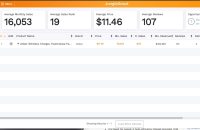It’s important to figure out what you want from Seller Central before investing in any tools or solutions. If you’re new, or even if you’re already a big seller, you’ll need to do this. It’s great to boost amazon seller analytics, but it’s not the end goal. A high-level goal like that can help you figure out which analytics software features are most important to you. For example, a tool with strong competitor analysis capabilities will help you grow your business.
A tool that helps you lower marketing costs, upsell your customers and understand your Customer Lifetime Value is essential for increasing profitability. Then you can think about the amazon seller analytics tools that can help you achieve your goals once you’ve better understood what you’re looking for. Starting Amazon’s free tools for sellers, such as Seller Central and Vendor Central, will provide you with plenty of data.
Starting with Amazon Advertising reports should provide you with a good basis for analysis. If a user qualifies to participate in Amazon Brand Registry, Amazon Brand Analytics (ABA) is the best free analytics option. The fact remains, however, that Amazon Sellers still need to trawl through several reports to get insights worth acting upon, even if Amazon has made some improvements, such as the ABA Search Term Report now reporting actual search volume instead of just the most popular search phrases.

It might work for small businesses to use these Amazon free reports. However, if you have many product listings, it can be harder for you to bridge the gap between data and action. In such cases, you should consider more sophisticated tools. As mentioned above, more sophisticated analytics tools will only benefit larger Amazon businesses.
When you are just starting out or if you run a small operation, you can use Amazon’s tools and augment that information into spreadsheets to get a lot done. With handy features like regular email delivery, if needed, Amazon makes all its information available in CSV files.
Exporting and saving the information is critical to building up long-term analytics since ABA doesn’t retain data indefinitely. By supplementing basic Amazon data manually, you can track long-term trends and develop personas that are far more accurate than demographic aggregates.
Using such tools, you can create a comprehensive view of customers by stitching together data from silos. By analysing advanced data using artificial intelligence and machine learning, you can quickly identify insights across a broad range of customer journey paths and prioritise the most promising ones. The best sales results can now be determined in near real-time by testing various approaches.






































































































